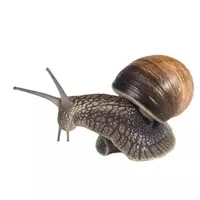Grape snail

Mussels, shrimp, oysters, squid, octopus, crabs have become quite frequent guests on our table. True connoisseurs and foodies are difficult to surprise with anchovies, frog legs or flying fish caviar. Let's expand our culinary horizons and get acquainted with a new product - the grape snail.
The phrase grape snail in a modern resident of a metropolis rather causes an association with an aquarium than with culinary art. Meanwhile, in many European and Asian countries, this product is a familiar item in the restaurant menu. Grape snails are often bred on special farms, and then sold not only alive or frozen, but also ready to eat. In addition, even snail caviar is eaten, which tastes like noble mushrooms.
It was not until the 20th century that the grape snail began to fall into the delicatessen category, as for many millennia it, like other mollusks, has been used as common food by inhabitants of the coastal regions of Europe. From the beginning of spring until the very late autumn, these snails could be easily harvested in gardens, on beaches or in vineyards. A real salvation for the poor and a treat for the nobility. Today, the grape snail is found not only on the warm shores of Europe, but also in the central regions of Russia, in Belarus and Ukraine.
If you are still tormented by the question of whether to use snails at all, you can say that the choice always remains with the person. Someone classifies these cute creatures as pets, and for some, the grape snail is the most valuable protein product with an extraordinary taste and a huge number of useful properties.
There can be no doubt about the benefits of snail meat, since this product contains no more than 90 kcal per 100 grams with a minimum amount of fat. In addition, the grape snail consists of polyunsaturated and unsaturated fatty acids, contains at least 15 percent protein and no cholesterol. Therefore, it is not surprising that these mollusks are rightfully considered powerful natural aphrodisiacs, comparable only to oysters.
When handling a grape snail harvested in the wild, two ways to cook it can be distinguished. In particular, it is easy to cook or bake on a fire along with a more complex process that requires a longer time period. If you settle on the latter, as a result you can taste a real piece of culinary art called escargo.
grape snails 90 kCal
Energy value of grape snail (Ratio of proteins, fats, carbohydrates - ju):
Proteins: 16.1 (~ 64 kCal)
Fats: 1.4 g (~ 13 kCal)
Carbohydrates: 2g (~ 8kCal)
Energy ratio (bj | y): 72% | 14% | 9%
 Español
Español Français
Français Português
Português Русский
Русский 简体中文
简体中文 繁體中文
繁體中文 日本語
日本語 한국어
한국어 العربية
العربية Türkçe
Türkçe Қазақ
Қазақ Deutsch
Deutsch Italiano
Italiano Українська
Українська
